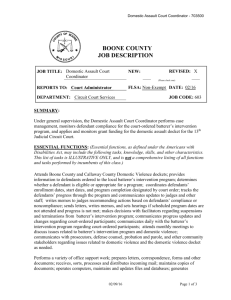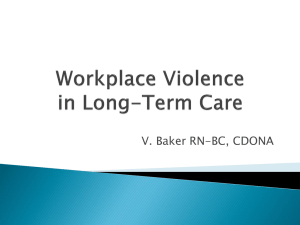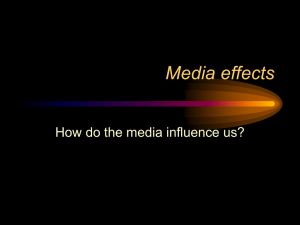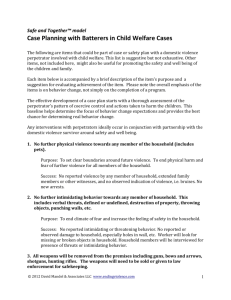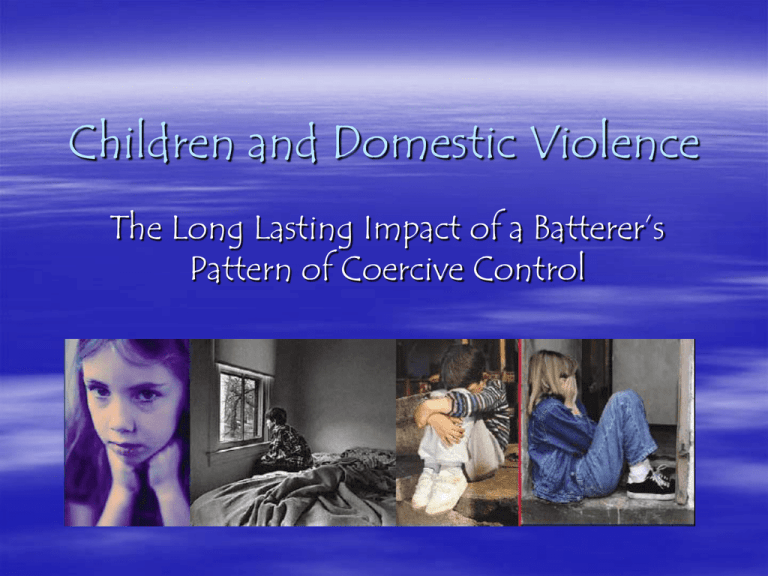
Children and Domestic Violence
The Long Lasting Impact of a Batterer’s
Pattern of Coercive Control
Goals of this Presentation:
1. Improve assessment for presence of
patterns of coercive control and impact
on children.
• Develop strategies to engage batterer
and support non-offending parent’s
safety planning. (traditional vs. nontraditional safety planning)
• Learn ways to identify family strengths
and promote resiliency.
As a provider, how many families have
you worked with that have been affected
by DV?
– Can you describe the patterns that you
noticed in the family?
– How many of you have had direct contact
with the batterer?
Can you describe that experience?
What is
Domestic Violence ?
Defining Domestic Violence
A pattern of coercive control perpetrated by
one person against another in an intimate
relationship.
Obvious
Physical assault
Threats to bodily harm
Kidnapping
Stalking
Sexual assault
Subtle
Name calling
Threatening to use the
court and DCF to take
away children
*Outing someone to
their relatives
Telling lies
Throwing out birth
control pills
Controlling finances
Cheating
Keeping weapons in
the house
Hiding passports
Controlling access to
phone and car
Restricted mobility
Children See, Children Do
What are the implications of the batterer’s
pattern of coercive control on children for
treatment?
Children living with DV are at risk for increased
or emotional and behavioral problems.
Children may be identified with “Serious
Emotional Disorders” and placed in special
education classrooms.
Early identification of difficulties can lead to
earlier and more effective support and
intervention for children and their families.
Children Exposed to Coercive
Control/Violence:
Watching, hearing or later learning
about a parent being abused (by a
partner) threatens children’s sense
of stability and security typically
provided by their family.
Children learn that violence in the
home is how to deal with conflict.
Impacts gender roles:
Being a man means you can use violence against a
woman.
Being a woman means being a victim.
Ambivalent
feelings toward
the abusive
parent and
non-offending
parent
Themes
There’s no
safe place
Adults
cannot
protect
themselves
or their
children
Takes on the
responsibility
of protecting
the victim
Chronic fear leads
to aggression
Risks Posed to Children By Exposure to Batterers’
Pattern of Coercive Control
1. Exposure to threats and/or acts of violence.
2. Undermining mother-child relationships.
Talking negatively to the children about the abused
parent’s behavior.
3. Physical and/or sexual abuse by batterer.
4. Batterer as a role model.
5. Rigid or authoritarian parenting.
Risks Posed to Children By Exposure to
Batterers’ Pattern of Coercive Control
6.
Neglectful or irresponsible parenting.
7.
Psychological abuse and manipulation.
8.
Children’s bad behavior being used as the reason for the
assault of the non-offending parent.
Using children as a weapon.
9.
Not being willing to have children involved in treatment;
interfering with treatment.
Holding the children hostage in an effort to punish the victim.
Exposure to violence in their Father’s new
relationships.
Impact of Batterer’s Pattern of
Coercive Control at Different
Developmental Stages
Infants and Toddlers
Development
Impact
Implications for
Treatment
Take in information
from world around
them.
Form secure
attachments.
Active explorers of
their world and
learn through play.
Learn about social
interaction and
relationships.
Loud noises and vivid
images can be
distressing.
Inconsistency
responding to infants
needs, effecting the
parent-child bond.
Fear and instability
may inhibit
exploration and play.
Learn about
aggression by
observing others.
Prevention programs:
Parent Aid Programs
Birth to Three
Head Start
Parenting Classes
Fatherhood initiatives
Child Development
education.
Treatment plans that
involve both parents
with equal involvement
in responsible
parenting.
School Age Children
Development
Impact
Increased emotional
awareness of self and
others.
Complexity in
thinking about right
and wrong.
Academic and social
success has an impact
on self-concept.
Increase in same sex
identification.
Awareness of own
reactions to violence at
home and impact on
others.
Susceptible to
adopting
rationalizations heard
to justify violence.
Inhibits ability to
learn.
Implications for
Treatment
Intervention
programs:
Family therapy
Mentoring programs
Behavioral Mod
Techniques
Peer socialization
Play therapy
Treatment plans that
involve both parents with
equal involvement in
responsible parenting.
Adolescence
Development
Impact
Implications for
Treatment
Increased autonomy
Puberty (physical
changes)
Increased capacity
for abstract reasoning
and broader world
view
Increased peer
group influence and
desire to be accepted.
Relationship skills
Becoming parentified.
physical intervene to
stop the violence
Embarrassed by the
family resulting in
shame, secrecy, and
insecurity.
Unable to establish
peer groups.
Poor boundaries.
Inappropriate
decision-making
(emotionally based)
Intervention
programs:
Mentoring programs
Behavioral Mod.
Techniques
DBT
Skills groups (multi
family)
Assertive
communication skills
Each individual in
their own treatment
Coping Strategies
Maladaptive:
– Dissociation
– Affect Dysregulation
– Isolation
– Withdrawal
– Disorganization
– Lack of concentration
– Substance Use
– Violent Behavior
– Bullying
– Overachievement
– Excessive Caretaking of
Others
– Exploitation
– sexually inappropriate
behavior
– self-destructive behavior
Adaptive:
– Reworking of trauma
through play
– Meaningful connections
with others that offer
corrective experiences
– Being able to feel emotions
and still be OK
– Journaling feelings and
thoughts
– Sublimation of emotions
through activities (sports,
extracurricular activities)
– Assertive communication
– Use of a sense of humor
– Goal directed behavior
– Use of peer and community
supports
*Impact of Trauma on Caregiver-Child
Relationship
• When the caregiver has also experienced interpersonal trauma:
• The caregiver’s ability to establish and maintain an empathic
relationship with the child may be impaired
• The caregiver may have a decreased capacity to recognize
danger or stress
• The child may take the role of caregiver
Either partner may develop new negative attributions based on
trauma experience
– Changes to internal working models
– Traumatic expectations
Caregiver and child may serve as traumatic reminders for one
another
*Maxine Weinreb, Ed.D.
Child Witness to Violence Project
Impact of Domestic Violence on the
Father-Child Relationship
Fathers who are abusive have difficulty taking the perspective of
the child. They minimize the impact of violence on their children
Children are confused and ambivalent about their feelings
toward their fathers
Some children express anger and relief that their father is out of
the house
Some children express sadness/longing that their father is gone
Some children ally themselves with their father and see him as a
victim, especially if they have seen him arrested
*Maxine Weinreb, Ed.D.
Child Witness to Violence Project
Safety Planning Strategies and
How the Batterer can Interfere
TRO or PO
Cell Phones
Identify safe hiding places (DV or homeless shelter)
Call 911
Remove child from abusive environment; Bring child to
alternate, safe, location (ie: friend, relative, different room
within home)
Notify school officials, teachers, etc. of batterer’s potential
violence; safety plan; emergency contact, heighten
awareness to and possible change in child’s behavior
Sleep in same room with children
Talk to children about how to respond to violence, ie: stay
away from abusive/violent environment; respond to code
word; go to identified neighbor’s house, hiding place etc.
Move out of home with/without children
Safety Planning Strategies and
How the Batterer can Interfere
Sleep in car/street (extreme example of children in ”trunk”
incident)
Identify person to assist with visitation to reduce potential for
violence during transfer of children
Keep children out of school/change schools
Make sure they attend school
Normalize as much as possible by providing a safe structure
Meeting basic needs (feeding, bathing, spending quality time)
Keeping up to date medically
Maintaining a routine to avoid exposure to possible violence
Engaging children with outside activities and relationships
(formal and informal)
Attending school functions such as parent-teacher
conferences, fairs, etc.
Goals of Child Assessment
To begin to hear the child’s story
To begin to understand what meaning the child
attributes to the event(s), what was the worst part
of the experience, and what fears the child may
have
To understand how the child has been impacted by
the violence and how the child is coping
To identify protective factors in the child including
learning strengths, relationship skills, coping
abilities, and self regulatory capacity.
To observe style and qualities of attachment
relationship between parent and child
*Maxine Weinreb, Ed.D.
Child Witness to Violence Project
When a child discloses…
Allow child to tell his or her story
Reassure the child by validating his or her
feelings
Do not criticize or speak negatively about the
abusive parent
Do not make commitments you cannot keep
Follow the child’s lead
Reassure that nothing that
happened was their fault
“Kids need you. Take the time to get to know us -- even when we’re
difficult to befriend. Don’t just think we’re bad kids even though we may
be acting bad. We can heal. But we may keep making wrong choices as
we deal with the abuse. If you take the time to help us, we’ll know
someone cares and we’ll get back on track,” (Anonymous, 2004).
Contact Information
Gail Manna, DV Consultant (DCF
Waterbury)
gail.manna@ct.gov
Carolina Grijalba-Rodriguez, DV
Consultant (DCF Danbury & Torrington)
carolina.grijalba-rodriguez@ct.gov




